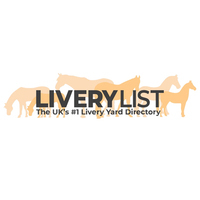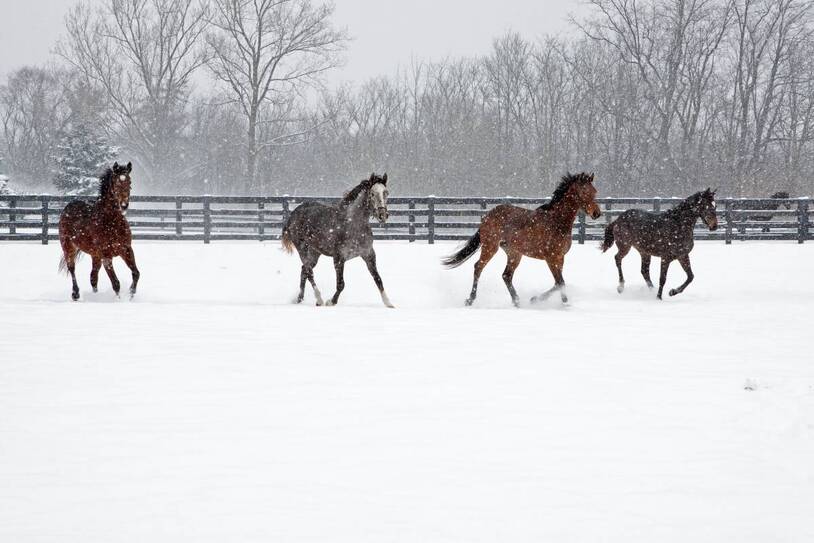Winter can be a tricky time for horse and yard owners, with shorter days, wetter weather, and less time to ride. Being prepared for the winter months in your yard can make these times easier, to plan ahead for seasonal eventualities and to make sure winter is an enjoyable time for all!
Year Round Grazing?
Make sure that you communicate with liveries if there may be any rules or restrictions on winter grazing. This may be shorter hours of turnout, restricted turnout if the ground is too wet or frozen, or extra costs for hay to be put in the fields.
Consider a contingency plan in these cases such as alternative turnout, perhaps in an arena, or the possibility to create smaller turnout areas to allow continued turnout but reduce the fields being damaged in the long term.
Although it can be difficult to manage wet and muddy paddocks, the labour and costs for additional bedding and forage when horses are stabled for longer can be counteractive compared to putting in place the facility for at least some daily turnout for the horses in the yard.
Be Ready for the Freeze!
Inevitably there will be days where the temperature is low enough to freeze standing water, troughs, and pipes so it's important to be prepared in advance to know that you can provide fresh running water in the yard.
In terms of water sources freezing in the yard, there are a few solutions. The best option is to try to lag and insulate any pipes or taps that may be at risk of freezing, prevention is certainly better than dealing with no water early in the morning! It is also an idea to store water the day before where it can be easily accessed the following day if the pipes do freeze, such as filling buckets or water butts, ensuring there is at least enough to provide a day's worth of drinking water for the horses. Having a kettle in the yard can be useful too for defrosting pipes, but remember you’ll still need to make sure the kettle is left filled up!
For troughs, the age-old trick of a rubber duck or a tennis ball floating to break the surface of the water usually does the job of stopping troughs from freezing, but even so, it is important to check regularly that horses have access to fresh water, especially with self-filling troughs where the taps may freeze so make sure you check each trough or bucket and break the ice regularly on very cold days, even in stables.
Banish the Mud (or at least try to!)
There is nothing worse than muddy tracks or gateways when trying to manage horses in the winter. Any forward planning that can make gateways safer can be helpful. Adding mud mats or similar to gateways can at least offer a stabilized surface in some areas, but other steps can include moving gateways or having multiple gateways where possible- such as with electric fencing- and taking steps to reduce horses grouping in gateways at bring-in time.
If you provide loose hay in the fields or large hay feeders, try to move these regularly to prevent muddy areas from developing, where the horses will be regularly stood for long periods. If possible, place the hay or feeders on a permanent or temporary hardstanding such as mud mats, concrete or even wood chips to help keep down the mud.
Reduce the Risk of Slips and Trips
First and foremost,
making sure access to the yard is safe is an absolute must. Humans or horses slipping on frozen ground can cause severe injuries and it’s important to remind staff and liveries to not leave standing water in the yard. Think about where hosing off and washing down areas are situated and that there is adequate drainage to move the water from potentially dangerous areas. Also, to ensure that horses are not left dripping, or troughs or buckets left to overrun.
With darker nights it’s also important to ensure the yard is well-lit too, especially in areas where people will be handling horses. If you don’t have the facility of mains lighting, various solar or battery-powered setups will provide adequate light with a good run time.
Making sure the access paths in the yard are kept clear as well is important. With the addition of potentially multiple rugs for each horse, it can easily see an increase in items being kept on and around the yard. Not only do items being left out risk getting wet and muddy but also pose a risk to movement in the yard as well for both humans and horses.
Keep Things Clean!
It’s important to make sure that it's possible to access fresh water to ensure that items can be cleaned, hands can be washed, and any injuries can be dealt with, such as hosing off legs. Having a hardstanding away from mud can be a huge bonus even for the smallest of yards, and especially helpful for the attendance of vets and farriers to give them a clean workspace.
It’s worth
discussing your liveries' plans for muddy legs! If you have lots of liveries being brought in from muddy fields every evening, you may not want each one to have their legs washed off every night for risk of huge use of water in the yard but also need to ensure that their legs are cleaned regularly. It's also a good idea to make sure feet are picked out each evening when brought in, or at least the following morning before turnout. To both reduce mud in the yard and to check all is well with their feet.
It's also an idea to have a designated space for wet and muddy rugs, such as a dedicated rug room or even a rug drier in the yard. Trying to keep muddy items out of walkways and tack rooms can be a good idea, and asking horse owners to be conscious about where they leave muddy items can also prove beneficial.
Keeping the yard clean, neat and clear of unnecessary items can also mean it's always ready for visitors such as farriers or vets, and also means that if you have
livery vacancies available, it will be neat and ready for inspections and potential liveries!
Keep it Calm!
With less turnout and possibly less riding due to short days or bad weather, many horses can easily become agitated with less exercise. It is therefore important to be able to keep horses entertained whilst they are stabled and to ensure that ideally, all horses escape the stable for a stretch of the legs at least half an hour a day. If you have a horse walker this can be ideal in times of restricted turnout and riding, but failing that, even a walk in hand, a short lunging session or the use of a small all-weather turnout area can be a godsend.
Stable toys and mirrors can be a good idea to help horses stay occupied when stables and ensuring that horses can see one another can also be an advantage. It is important also to consider appropriate feeding for horses who may be on a reduced workload and review feed regularly to ensure they are not being overfed. Some horses may also do better than others over the winter, and the poor-doers may need additional supplements or forage to give them the nutrients that they need.
Winter Riding
With shorter days, finding time to ride can be tricky. Think of ways that you can facilitate your liveries being able to ride in the winter months, be it providing riding on your land to avoid riding on the road when visibility is bad, the use of
indoor arenas, or the provision of temporary or permanent floodlights for outdoor riding spaces. A dedicated area for lunging can give an additional space to exercise horses and not disturb those who may be riding, especially when there may be a higher demand given the shorter hours. If your arena is prone to freezing, flooding or other weather-related issues, make sure you are maintaining the surfaces regularly to avoid any accidents or restrictions on their use.
Best of all… plan ahead!
Overall, it's best to consider and plan for any eventuality in the yard that may affect the care of horses. A lack of turnout, lack of electricity and water, and even the possibility that owners cannot come to the yard due to extreme weather must all be considered, and suitable plans put in place to help ensure that the care of the horses can be maintained. Make sure you keep open lines of communication with liveries so that everyone is organised and prepared, and make sure you have any necessary items in the yard, such as plenty of buckets or emergency lighting, ahead of time!
Livery List and the
Yard Owner Hub are industry-recognised resources to help yard owners promote and manage their equestrian premises. LiveryList offers you the opportunity to promote your livery yard, services and facilities. On the Yard Owner Hub, you can find thousands of free resources, guides and templates to help yard owners understand the practical and administrative management of their yard brought to you in conjunction with leading equestrian associations and organisations.



